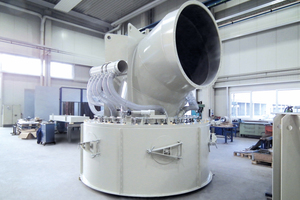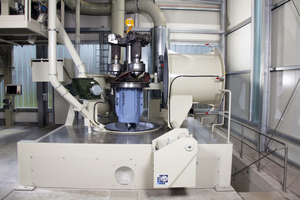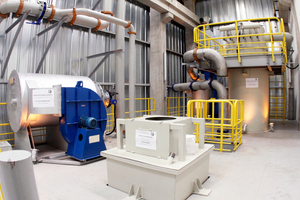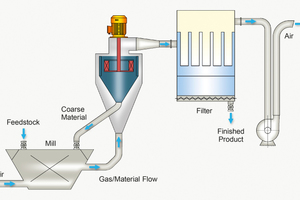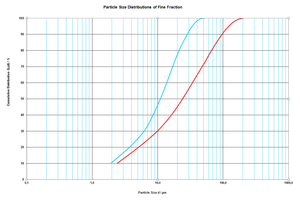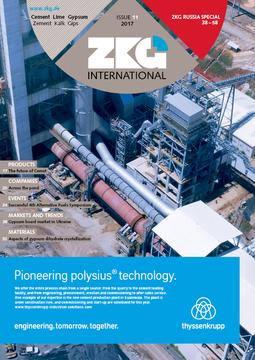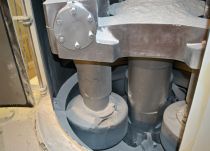Neuman & Esser builds classifier DC 2990
A limestone producer located in Europe pulverizes limestone (CaCO3) with high calcium carbonate content as filling material for the construction industry. Brick manufacturing is a frequent application for CaCO3.
Because clay also consists of silicon dioxide, aluminum oxide, feldspar and iron oxides, the bricks acquire their typical brown, pink or red hue, depending on the amount of iron oxide in the clay. If calcium carbonate is added to the mixture, the brick color changes to a yellow or cream hue. With the additional use of coloring agents, a Neuman & Esser (NEA) mill customer augments the color range in order to achieve a wide-ranging portfolio of trendy facade bricks.
The limestone producer operated a roller mill and a radial classifier from a NEA competitor. From the outset, the system did not provide the required performance. The system did not grind the material to the required quality and did not reach the promised throughput at any time. The mill vibrated too much and was too noisy stated the NEA Area Sales Manager, who contacted and consulted the customer frequently.
The NEA milling and classifier experts inspected the CaCO3 grinding system and discovered that the installed classifier was unfavorably designed and the flow routing had several faults. The engineers determined that it was not necessary to redesign the entire system; according to their calculations it was sufficient to exchange the classifier. The ductwork design also had to be adapted and optimized.
System engineering one step further
In order to meet individual customer requirements, a specialized product portfolio of mills, classifiers, filters and other system components is available. Prior to designing the system, customer-specific grinding and classifying tests are run in order to guarantee the perfectly tailored design of the system. Moreover, new developments in all areas guarantee a state-of-the-art solution for all customer requirements.
Since 1982 the scale-up and design of the grinding and classifying systems for customers are solidly based on the results of the NEA Mahl- und Sichtsysteme’s Test Centers in Germany and lately in Brazil. The systems components can be configured and applied variably for grinding, classification and solid particle separation tests, both in cyclones and/or in filters. The parameters for the individual materials such as particle size distribution, hardness, moisture or density are also determined here.
In this regard, the nominated project manager controls all interdisciplinary activities. The consistent project-orientated process structure offers the customers the advantage of a single responsible contact person for all technical requirements. In addition to targeted coordination of the activities, he is also responsible for the compliance with the quality, budget and project schedules.
As a result in this project, Neuman & Esser Mahl- und Sichtsysteme designed an innovative radial classifier, the DC 2990, using the gas/material flow coming from the mill and feeding the rejected coarse material back into the grinding process.
This classifier was designed directly with the largest construction size to-date without prior milling and classifying experiments at the NEA Test Center. Based on detailed calculations, the NEA R&D department determined the housing dia-meter at 3 m.
Comprehensive service portfolio for life cycle management
The DC 2990 was installed one year later and impressed the customer instantly, and that for a good reason, because the customer was provided with good results against very reasonable investment costs.
Pressure loss within the system was minimized and consequently energy requirements reduced. The mill itself now runs with considerably fewer vibrations and far more quietly, resulting in a reduction of the servicing costs because damage is no longer incurred. The most important fact for the customer was the throughput. Depending on the required fineness, throughput increases of between 20 % and 60 % were achieved.
Grinding systems have been used over several decades and the milling requirements can change over time. Reasons for this can be improvement of machine efficiency but also changed process parameters. As NEA Mahl- und Sichtsysteme only exchanges those components which are important for the new process, considerable cost savings can be achieved by revamping as opposed to purchasing new equipment and systems. Or – as in this case – the grinding and classifying experts conduct modifications to optimize the current process.
//www.neuman-esser.de" target="_blank" >www.neuman-esser.de:www.neuman-esser.de

